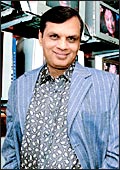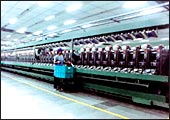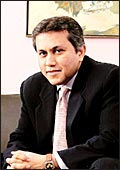 |
| Global designs: M&M
(above) and Suzlon's overseas bases |
 |
$186 billion.
1,878 deals.
And a global market share of 16.8 per cent.
It's unusual
to start a voluminous, predominantly gung-ho series of features
on India's MNCs in the making with a reality check. But that may
be just what the doctor ordered in the midst of reams of hoopla
generated in recent times about India Inc.'s burst of acquisitions
on the international stage. According to data collated by the
us-based information powerhouse Thomson Financial, us corporations
have done 1,878 cross-border transactions so far in 2006, totally
valued at $186 billion. India stands 23rd on that list in value
terms, with a 0.7 per cent share. Elsewhere, India ranks 61st
out of 62 countries on the globalisation index of A.T. Kearney,
a global management consulting firm. Does that mean India Inc.
is still a bashful pretender, unable to convincingly announce
its arrival in the Global Village, a Tata-Corus here or a Videocon-Thomson
there notwithstanding? Not quite. As you turn the page, you will
see how Indian business is slowly but surely beginning to leave
its indelible mark on foreign markets. New markets, resources
and clients are being accessed, and people of varied ethnic hues
are on the payrolls of Indian firms. Watch out, world: The Indian
MNC is coming soon to a town near you.
Financial Buy Anytime,
Anywhere
Overseas assets aren't
coming cheap, but that's not deterring Indian companies from using
acquisitions as a strategy to get a global footprint.
By Krishna Gopalan
 |
| Ready to roll: Tata Motor's
Ratan Tata (centre) at a Daewoo plant in South Korea |
Sometime in the
mid to late 90s, British Steel mandated a well-known global investment
bank with a specific brief to scout around for opportunities in
the Indian sub-continent. One proposal the bank apparently made
to British Steel involved picking up a majority stake in the country's
largest private sector steel maker, Tata Steel. The deal didn't
materialise, and British Steel went on to merge with Koninklijke
Hoogovens of the Netherlands in October 1999. Together they formed
Corus-the same company that Tata Steel recently agreed to buy
for $8 billion.
Call it irony or serendipity or just pure
bravado, the Tata Steel-Corus transaction is best evidence of
the hunger of Indian promoters to hog the global stage. It's also
confirmation of how one acquisition can transform the acquirer
from a distant also-ran into a global giant to reckon with. From
the mid-50s in the global steel ranking, Tata Steel has pole-vaulted
into the league of the top five steel producers worldwide. From
a company with a topline of Rs 17,000 crore, the Tata Steel-Corus
combine sails into the Rs 1 lakh crore ($22 billion) bracket (Corus
showed sales of Rs 85,000 crore in 2005).
 |
 |
"The financing
(of the Hansen transaction) was completed in less than 10
days and the clincher was that we moved faster than the competition"
Girish Tanti
Director/Suzlon |
"The Thomson acquisition
gave us access to a global market. Today, we are taken seriously
and our brand name has become much stronger"
Venugopal Dhoot
Chairman/ Videocon Group |
Tata-Corus isn't just a one-off example of
an Indian business house thinking, and acting big. Videocon Industries'
$731-million bid for Daewoo Electronics, Dr Reddy's acquisition
of betapharm in Germany for $572 million, Ranbaxy's $324-million
buyout of Terapia in Romania, and Suzlon Energy's $565-million
purchase of Hansen Transmissions of Belgium are just some instances
of Indian companies willing to shell out top dollar for instant
access to foreign markets. The deal frenzy isn't restricted to
a handful of sectors, nor is it the preserve of the elite of India
Inc. A host of mid- and small-cap firms in industries ranging
from textiles, consumer durables, fast moving consumer goods and
telecom to energy, automobiles, auto components and information
technology are participating in the rush to cut an outbound deal.
The number of deals taking place is increasing, as is their value.
In 2005, the total number of outbound deals was 136, generating
a total deal value of $4.3 billion. Between January and October
this year, the value of outbound deals was about three and a half
times more at $15.72 billion and without question, will be significantly
larger by the end of the year. "This is the result of confidence
among Indian promoters which might not have been the case three
years ago. The most important thing is that we have achieved competitiveness
at the global level," points out Rajeev Gupta, Managing Director
and Head of the India Buyout Team, Carlyle.
 |
"Tata Steel will
be in several geographies rather than the limited geographies
that we have today. It will have access to R&D facilities,
and new markets"
B. Muthuraman
MD/Tata Steel |
And what better way to prove that by having
a go at international markets, developed and developing. Videocon
Industries is an instance of a consumer durables company wanting
to take its brand to foreign shores. The group bought Thomson's
colour picture tube manufacturing facility and has now inked an
understanding with Korea's Daewoo Electronics. "The Thomson
acquisition gave us access to a global market. Today, Videocon
is taken seriously and our brand name has become much stronger,"
says Venugopal Dhoot, Chairman, Videocon Group. Importantly, the
global strategy doesn't begin and end with one or two acquisitions,
but involves a host of them over the longer term. It is now gathered
that Videocon has trained its sights on the Seoul-based LG.Philips
LCD Co.
Also pursuing a string of acquisitions is
Ranbaxy Laboratories which, in 2006 alone, made five purchases.
An entry to high-growth geographies is one big reason for the
buying binge. According to Ramesh Adige, Executive Director, Ranbaxy,
the acquisition of a 96.7 per cent stake in Romania's Terapia
opened up possibilities in the rapid-growth markets of Romania,
central and western Europe. "The combination of Terapia with
Ranbaxy's existing activities in Romania has created the largest
generics company in the country. Physical proximity to the markets,
high quality and efficient low-cost manufacture, state-of-the-art
R&D and product registrations are the underlying reasons (for
the acquisition)," he adds. Market access is clearly the
mantra for many of the companies stepping out. Says B. Muthuraman,
MD, Tata Steel: "Tata Steel will be in several geographies
rather than the limited geographies that we have today. It will
have access to technology, management expertise, R&D facilities,
geographical reach and new markets," he says.
| THE CASE FOR OUTBOUND DEALS |
| WHY THEY MAKE SENSE
» Access
to global markets: Ranbaxy's buyout of Terapia has given
the buyer a clear access to high-growth markets like Romania
and Eastern Europe
» Synergy
with the existing business of the buyer: Videocon's acquisition
of Thomson gave it a strong presence in the colour picture
tube market. That will be complemented by Daewoo's presence
in areas like high-definition televisions and digital televisions
» Strengthening
the buyer's presence: Tata Tea's buyout of Tetley gave it
a foothold in the UK market. The deal with Glaceau will
allow Tetley to enter the US market and give Glaceau a chance
to tap the UK market
» Reduces
levels of vulnerability: Tata Steel's buyout of Corus makes
it a global top 5 player and reduces its risk to fluctuating
prices, In fact, it could also control prices now
» Chance
to create a global company: ONGC with acquisitions in oil
fields in Brazil and Syria is now a serious contender in
the global oil and gas space
WHAT COULD BE THE RISKS
» Takes
time to understand global markets: Companies often have
to rely on information from secondary sources which may
not be necessarily authentic
» Regulations
in global markets could be a dampener: Industries like pharma,
healthcare and energy are often looked at very closely by
the regulators
» Danger
of making acquisitions when an industry is on an upswing:
The buyer could take a long time to recover investments
if the cycle turns
» Cultural
integration issues: Factors like language and the seller's
employees having new owners could be hurdles
» Economic
downturn in the global market: This could play havoc with
the buyer and will severely affect business prospects and
forecasts
|
A few years ago, if there was one perceived
stumbling block to global size deals, it was finance. Today, that's
hardly an issue, what with private equity players and bankers
falling over each other to bankroll acquisitions by Indian companies.
What also helps is that many of the acquisitions begin paying
back almost immediately. Adige of Ranbaxy says Terapia has been
accretive from day one (the acquisition was funded from the proceeds
of Ranbaxy's $440 million issue of foreign currency convertible
bonds). In Dr Reddy's Labs case, betapharm contributed 12.77 per
cent to the top line in the second quarter of 2007. What also
helps are balance sheets that are capable of absorbing larger
quantities of debt and proposed investments, courtesy healthy
cash flows. "Indian companies are generally in very good
financial health today. This coupled with an access to significant
pools of capital is driving M&A appetite," says Pramit
Jhaveri, Managing Director and Head of India Investment Banking,
Citigroup.
Another big deal that sailed through on the
financing front is the Suzlon-Hansen transaction for m431.43 million
(Rs 2,459.15 crore). The acquisition was funded entirely by debt
from ICICI Bank, the State Bank of India, Deutsche Bank and Barclays.
"The financing process was completed in less than 10 days
and in our case the clincher was that we moved faster than the
competition," says Girish Tanti, Director, Suzlon. Bankers
for their part aren't prone to financing deals blindly. "We
look at benefits of synergy with respect to products, processes,
manpower and commercial benefits. It is after assessing these
that we look at costs and risks," says Jitender Balakrishnan,
Deputy Managing Director, IDBI Bank.
HOW THEY DID IT
Sticking to the Knitting
By buying quality but operationally-stressed
assets on the cheap, Spentex Industries has become India's
largest yarn maker. |
 |
| Spinning success: Via
six acquisitions in three years |
 |
Here is one company that has
emerged virtually from nowhere to become the largest yarn
manufacturer in the country. Three years ago, its promoters
weren't even in the textiles business, running a profitable
trading house called CLC Global. Today, Spentex Industries
has a total manufacturing capacity of nearly 570,000 spindles
in India and Uzbekistan, edging out erstwhile leaders Mahavir
Spinning (550,000 spindles). Nearly 85 per cent of that capacity,
or 484,000 spindles, has been added via six acquisitions in
the past three years. And roughly 40 per cent is accounted
for by one overseas buyout, in Uzbekistan, of 220,000 spindles
(plus 236 airjet looms). Mukund Choudhary, Managing Director,
Spentex Industries, who is credited with much of this creation,
shares his rationale for inorganic growth: "Nine out
of 10 people who set up greenfield projects fail." More
importantly, it's cost-effective too. For instance, Spentex
bought the Uzbek facilities with an investment of just 40
per cent of what it would cost to build similar capacities.
Spentex is now looking for more acquisitions, primarily
overseas, to grow even bigger. "Asset sizes are much
smaller, while valuations are higher in India," says
Choudhary. His aim is to push up capacity to between 700,000
and 1 million spindles over the next 12-18 months and turnover
to Rs 1,800 crore by March 2008, which would mean a five-fold
growth over last year's sales.
Spentex may be more keen on foreign assets today, but
his first acquisitions were Indian. Choudhary's first deal-Cimmco
Spinners, which is now Spentex's unit in Solapur in Maharashtra-was
done over dinner in October 2003. Cimmco was making losses
when it was bought from Xpro India, an S.K. Birla group
company. "It was no gamble. I fear losing even Rs 10.
So, buying Cimmco was a pure, logical business risk given
the strength of our raw material procurement, our marketing,
human and financial strengths." Cimmco pitched in with
a modest profit of Rs 1.60 crore within six months of being
acquired. In 2004, Choudhary acquired his Baramati unit
(also in Maharashtra), which was known as Spentex Industries,
and which is the name the company has hung on to. Subsequent
acquisitions were in Ahmedabad, Nagpur, Indore and Kolhapur.
Barring two units bought from Indo Rama and the Uzbek capacitiy,
all the other acquisitions were loss-making or sick companies.
This is in line with the company's strategy of buying quality,
operational but stressed assets on the cheap.
And backing the aggression is financial savvy too. The
company has managed to do nearly every kind of financial
deal in the last few years, ranging from a buyback to open
offers to private equity. Citigroup Venture capital invested
$15 million for the Uzbek deal. In August, Spentex also
became the first company to raise funds (Rs 46.60 crore)
via the newly opened qualified insitiutional placement window
from Sundaram Mutual Fund, Goldman Sachs, Voyager Fund and
Nikko Asset Management.
Not yet 35, Choudhary typifies the new breed of Indian
entrepreneurs-young, hungry but patient and well prepared.
The man who is "desperate for profits, but not for
acquisitions", sees a turnover of Rs 1,400 crore this
financial alone. Choudhary writes out his targets in pencil,
to rewrite them later. If the acquisitions keep coming,
it won't be long before Choudhary begins penciling a new
number.
-Shalini S. Dagar
|
From the spate of deals concluded, it's clear
that there's plenty of opportunity out there. And tracking them
are not just eager investment bankers but company head honchos
themselves. For instance, when Tata Tea zeroed in on bottled water
marketer Glaceau in a landmark $677-million deal, the company's
top brass glanced over a host of options. Says R.K. Krishna Kumar,
Vice Chairman, Tata Tea: "We scanned the market and we looked
through many companies. There were some fruit juice companies
that were interesting, but not exciting enough. The fact that
Glaceau is in a category that is changing the beverages market
was exciting."
 |
 |
"Indian companies
are generally in very good financial health today. This coupled
with an access to significant pools of capital is driving
M&A appetite"
Pramit Jhaveri
Head/Investment Banking/Citigroup |
"This is the result
of confidence among Indian promoters. The most important thing
is that we have achieved competitiveness at the global level"
Rajeev Gupta
MD/ Carlyle India Buyout Team |
Investment bankers, for their part, do their
bit by constantly looking for opportunities. DSP Merrill Lynch,
which represented Tata Motors in the buyout of Daewoo's truck
manufacturing facility, has a standardised procedure for cross-border
deals. "Typically, we take an industry and understand it
in detail from where we identify specific opportunities for Indian
players. Importantly, these opportunities have to be appropriate
and must offer strategic fits for the Indian company. From this
stage, we take the opportunity to the client, which facilitates
a strategic discussion," says Munesh Khanna, MD and Head
of Investment Banking, DSP Merrill Lynch.
One welcome upshot of the flurry of outbound
M&A is that Indian managers have little choice but to consider
the global big picture when making decisions. Consider for instance
VSNL's $239-million buyout of Teleglobe, which gave the Tata company
a foothold in the international voice market, estimated at about
220 billion minutes per annum. The Indian pie-incoming and outgoing-will
be about 12 billion minutes by the end of the current year. But
as N. Srinath, Executive Director, VSNL, says: "I do not
think of what is happening to ILD (international long distance)
traffic in India. I think of what is happening to the ILD traffic
globally."
|














